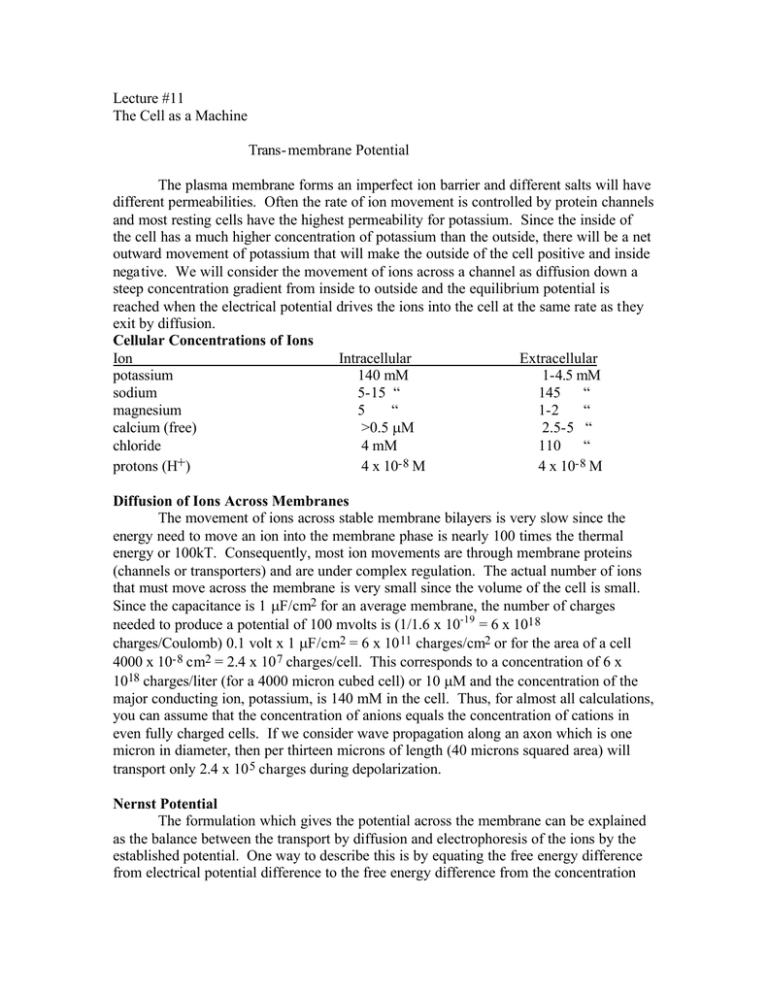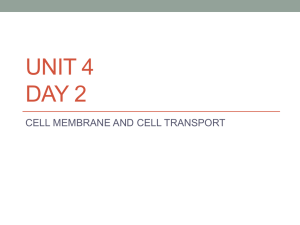Lecture 11
advertisement

Lecture #11 The Cell as a Machine Trans- membrane Potential The plasma membrane forms an imperfect ion barrier and different salts will have different permeabilities. Often the rate of ion movement is controlled by protein channels and most resting cells have the highest permeability for potassium. Since the inside of the cell has a much higher concentration of potassium than the outside, there will be a net outward movement of potassium that will make the outside of the cell positive and inside negative. We will consider the movement of ions across a channel as diffusion down a steep concentration gradient from inside to outside and the equilibrium potential is reached when the electrical potential drives the ions into the cell at the same rate as they exit by diffusion. Cellular Concentrations of Ions Ion Intracellular Extracellular potassium 140 mM 1-4.5 mM sodium 5-15 “ 145 “ magnesium 5 “ 1-2 “ calcium (free) >0.5 µM 2.5-5 “ chloride 4 mM 110 “ protons (H+) 4 x 10-8 M 4 x 10-8 M Diffusion of Ions Across Membranes The movement of ions across stable membrane bilayers is very slow since the energy need to move an ion into the membrane phase is nearly 100 times the thermal energy or 100kT. Consequently, most ion movements are through membrane proteins (channels or transporters) and are under complex regulation. The actual number of ions that must move across the membrane is very small since the volume of the cell is small. Since the capacitance is 1 µF/cm2 for an average membrane, the number of charges needed to produce a potential of 100 mvolts is (1/1.6 x 10-19 = 6 x 1018 charges/Coulomb) 0.1 volt x 1 µF/cm2 = 6 x 10 11 charges/cm2 or for the area of a cell 4000 x 10-8 cm2 = 2.4 x 10 7 charges/cell. This corresponds to a concentration of 6 x 1018 charges/liter (for a 4000 micron cubed cell) or 10 µM and the concentration of the major conducting ion, potassium, is 140 mM in the cell. Thus, for almost all calculations, you can assume that the concentration of anions equals the concentration of cations in even fully charged cells. If we consider wave propagation along an axon which is one micron in diameter, then per thirteen microns of length (40 microns squared area) will transport only 2.4 x 10 5 charges during depolarization. Nernst Potential The formulation which gives the potential across the membrane can be explained as the balance between the transport by diffusion and electrophoresis of the ions by the established potential. One way to describe this is by equating the free energy difference from electrical potential difference to the free energy difference from the concentration difference. An analogous treatment considers a force, X (change in energy per unit length) X = -dµ/dx = -(RTdc/cdx + zFdΨ/dx) where µ is the activity of the ion, c is the concentration of the ion, z is the charge, and Ψ is the potential. At equilibrium, when the activity is constant along x, X = 0 and we can solve for Ψ giving the relationship below Ψ = 2.3(RT/zF)log(c 1/c 2) This relationship applies for all diffusing ions and often there are antagonistic gradients that cancel each other’s effects and result in a low final potential. Donnan Potentials The formulation above does not require that there be a membrane barrier in place. A membrane will make it possible to select the ions that are transported through specific channels. In the absence of a membrane, fixed charges and their counterions can produce potential gradients as if there were a semipermeable membrane present (in a way, the immobilization of charges on a matrix is analogous to having a membrane that is not permeable to those charges). Thus, the Nernst formula applies to all situations where there is electrical and diffusional connectivity across a boundary. Problems: 1. We talked about cell depolarization as the change from being permeable to potassium to being permeable to sodium. If the only ions that move during the depolarization of a cell are sodium ions, then how many ions will mo ve in a cell with a membrane area of 4000 microns squared and a volume of 4000 microns cubed upon depolarization (assume outside K+ is 3 mM and inside Na+ is 4 mM). 2. If we assume that 100 mM of anionic charges are immobilized on DNA in the nucleus, then what will be the potential developed by a Donnan equilibrium from the inside to the outside of the nucleus with a cytoplasmic concentration of 100 mM NaCl? Remember that a diffusion potential can be generated by either positive or negative charges.

